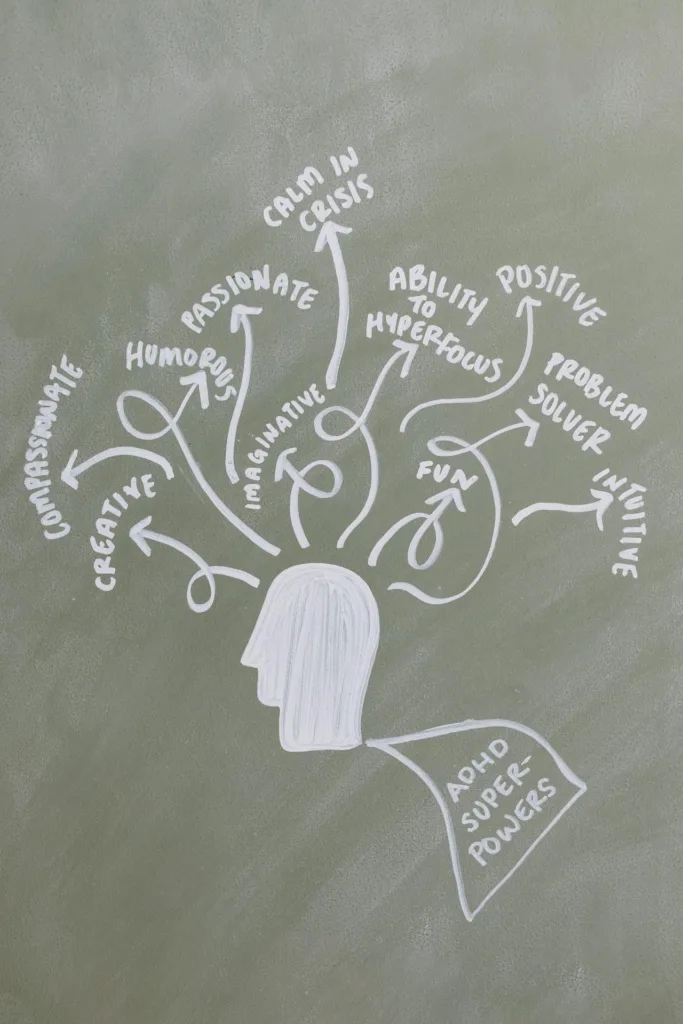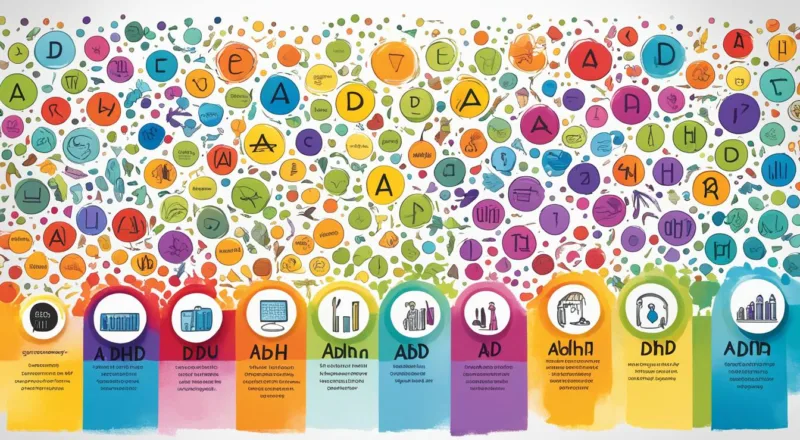7 Types of ADHD: A Comprehensive Guide to Understanding Your Brain in this Hectic World of 2024
What is ADHD?
ADHD stands for “Attention Deficit Hyperactivity Disorder”. It’s a neurodevelopmental disorder that commonly begins in childhood and can persist into adulthood. Individuals with ADHD may struggle with attention, impulse control, and hyperactivity.
There are three main types of ADHD: primarily inattentive, primarily hyperactive-impulsive, and a combination of both. Inattentiveness, distractibility, impulsivity, and restlessness are common symptoms. ADHD can impact various aspects of life, including academic performance, work, and relationships.
Diagnosis is typically made based on a thorough evaluation of symptoms and their impact on daily functioning, and treatment often involves a combination of behavioral therapy, psychoeducation, and sometimes medication.
Introduction:
In the busy year of 2024, with constant activity and daily challenges, it’s important to understand our minds as a source of stability. Today, let’s explore the world of ADHD on a journey of self-discovery. Think of it like a map for your brain, helping you navigate through complex thoughts. This guide will break down the “7 Types of ADHD,” connecting with you on a personal level. Understanding our unique minds brings growth, resilience, and a connection to our story.
Key Takeaways:
- There are 7 types of ADHD, each with unique characteristics and challenges.
- Understanding your specific type of ADHD can help you find effective treatment options and strategies.
- ADHD is a complex condition that affects focus, behavior, and overall well-being.
- By exploring the 7 types of ADHD, you can gain insights into your own brain and experience.
- Embracing your ADHD story and seeking support can lead to growth and resilience.
7 Types of ADHD -Understanding ADHD Subtypes
ADHD, or Attention Deficit Hyperactivity Disorder, is commonly categorized into subtypes, each reflecting distinct patterns of symptoms.
- Classic ADHD: Characterized by a combination of inattention, hyperactivity, and impulsivity.
- Inattentive ADHD: Primarily marked by difficulties sustaining attention without prominent hyperactivity.
- Overfocused ADHD: Involves intense focus on specific tasks, potentially hindering flexibility and adaptability.
- Temporal Lobe ADHD: Associated with temporal lobe dysfunction, impacting aspects of memory and organization.
- Limbic ADHD: Involves emotional dysregulation, influencing mood and responses to stimuli.
- Ring Of Fire ADHD: Marked by heightened sensory sensitivity and intense emotional reactions.
- Anxious ADHD: Combines ADHD traits with heightened anxiety levels.
Understanding ADHD in the Modern Age

In today’s modern age, ADHD has become increasingly prevalent, affecting individuals of all ages. As we adapt to the demands of a hectic world, it is crucial to understand the evolution of “Attention Deficit Hyperactivity Disorder” and recognize the impact of our fast-paced, digitally connected lives on ADHD symptoms.
The Evolution of Attention Deficit Hyperactivity Disorder
Over the years, our understanding of ADHD has evolved significantly. Once seen as a primarily childhood disorder, we now know that ADHD can persist into adolescence and adulthood. With advancements in research and diagnosis, healthcare professionals have gained a deeper understanding of the complexities of ADHD, leading to improved treatment strategies and support systems.
Previously, ADHD was often misunderstood or mischaracterized, with misconceptions surrounding its causes and impact. Today, we recognize ADHD as a neurodevelopmental disorder, influenced by a combination of genetic, neurological, and environmental factors.
Recognizing the Impact of a Hectic World on ADHD
The fast-paced, technologically driven world we live in can have a profound impact on individuals with ADHD. The constant stimulation, digital distractions, and high-pressure environments can exacerbate ADHD symptoms, affecting focus, attention, and overall well-being.
While technology has its benefits, such as providing tools for organization and productivity, it can also pose challenges for individuals with ADHD. The constant availability of information and the need for quick decision-making can lead to sensory overload and increased impulsivity.
Furthermore, the demands of a hectic world can contribute to stress, anxiety, feelings of overwhelm for individuals with ADHD. The pressure to constantly perform, meet deadlines, and multitask can heighten symptoms of inattention and restlessness.
ADHD Success in the Digital Age
To effectively manage ADHD in the modern age, it is essential to develop tailored strategies that address the unique challenges posed by our fast-paced and digitally connected world.
As we delve deeper into the various types of ADHD and explore holistic approaches to treatment and management, it is crucial to understand how ADHD is impacted by the modern age. By recognizing the evolution of ADHD and acknowledging the challenges posed by our hectic world, we can empower individuals with ADHD to navigate their lives with resilience and success.
7 Types of ADHD
ADHD, or attention deficit hyperactivity disorder, is a complex condition with various subtypes or types. Understanding the different classifications of ADHD is crucial in gaining insight into how it affects our focus, behavior, and overall well-being. In this section, we will delve into the 7 types of ADHD, providing valuable insights into the characteristics of each subtype.
In order to navigate the complexities of ADHD, it is important to familiarize ourselves with the different types. By gaining a deeper understanding of these subtypes, we can better support individuals with ADHD and tailor treatment strategies to their specific needs.
Unveiling the Diversity: Exploring the 7 Types of ADHD in Depth
1. Combined Presentation:
Individuals with this type of exhibit both inattentive and hyperactive-impulsive symptoms. They often struggle with impulsivity, distractibility, and have difficulty sustaining attention.
2. Predominantly Inattentive Presentation:
This type is characterized by significant difficulties with attention and focus. Individuals may be quiet, withdrawn, and have a hard time organizing tasks and following instructions.
3. Predominantly Hyperactive-Impulsive Presentation:
This type is characterized by hyperactivity and impulsive behavior. Individuals may struggle with excessive talking, fidgeting, restlessness, and difficulties with self-control.
4. ADHD, Inattentive Type:
Individuals with this type primarily exhibit symptoms of inattention and have trouble sustaining focus. They may struggle with organizing tasks, completing assignments, and maintaining attention to details.
5. ADHD, Hyperactive-Impulsive Type:
This type is characterized by hyperactivity and impulsive behavior. Individuals may have difficulties sitting still, waiting for their turn, and expressing impulsivity in various aspects of their lives.
6. Unspecified ADHD:
This type is diagnosed when symptoms of ADHD are present, but do not meet the full criteria for any specific subtype. Individuals may exhibit a combination of symptoms that do not fit neatly into the other categories.
7. Other Specified ADHD:
This type is diagnosed when symptoms of ADHD are present, but the presentation does not fit into any of the defined subtypes. The specific presentation is described in detail by the healthcare professional.
Precision in Practice: Tailoring Interventions for Effective Diagnosis and Management Across the 7 Types of ADHD
By understanding the unique characteristics of each subtype, we can approach the diagnosis and management of ADHD with greater precision and effectiveness. Tailoring our interventions to address the specific challenges individuals face can lead to improved well-being, academic success, and overall quality of life.
Now that we have explored the 7 types of ADHD, let’s move on to the next section to uncover holistic approaches to ADHD treatment and management.
Holistic Healing: Tailored Approaches to ADHD Treatment
Treating ADHD holistically involves a combination of evidence-based approaches and natural remedies. By understanding the neuroscience behind ADHD and exploring personalized management strategies, individuals can develop a comprehensive treatment plan tailored to their unique needs. This section will discuss the connection between neuroscience and natural remedies and provide insights into crafting personalized ADHD management strategies.
Connecting Neuroscience and Natural Remedies
Neuroscience plays a vital role in unraveling the complexities of ADHD. It helps us understand the underlying brain mechanisms and provides valuable insights into effective treatment approaches. By exploring the relationship between neuroscience and natural remedies, we can discover holistic healing methods that complement traditional ADHD treatments.
Research has shown that certain natural remedies, such as dietary changes, exercise, mindfulness practices, and herbal supplements, can support brain health and enhance cognitive function. These natural approaches work in harmony with evidence-based treatments, offering a holistic approach to ADHD management.
Crafting Personalized Management Strategies
Every individual with ADHD is unique, and what works for one person may not work for another. That’s why crafting personalized management strategies is crucial in achieving optimal outcomes. By considering individual strengths, weaknesses, preferences, and lifestyle factors, we can develop tailored approaches to ADHD treatment.
Personalized management strategies may include a combination of medication, therapy, lifestyle modifications, and complementary therapies. These strategies consider the whole person and aim to address not only the symptoms of ADHD but also the individual’s overall well-being.
Holistic Healing Approaches for ADHD Treatment
| Treatment Approach | Description |
|---|---|
| Medication | Prescribed medications that help manage ADHD symptoms and improve focus and impulse control. |
| Therapy | Counseling sessions that provide support, coping strategies, and behavioral interventions to manage ADHD-related challenges. |
| Lifestyle Modifications | Changes in diet, exercise routines, sleep habits, and organization techniques to support overall well-being and ADHD symptom management. |
| Mindfulness Practices | Techniques such as meditation, deep breathing exercises, and yoga to improve focus, reduce stress, and enhance self-awareness. |
| Dietary Changes | Adjustments in nutrition that eliminate potential triggers, optimize brain health, and support cognitive function. |
| Herbal Supplements | Natural remedies, such as omega-3 fatty acids, zinc, and ginkgo biloba, that are believed to have beneficial effects on ADHD symptoms. |
ADHD Misconceptions vs. Reality

There are numerous misconceptions and myths surrounding ADHD, and it’s important to separate fact from fiction. In this section, we will explore common misconceptions about ADHD and provide the reality behind these misconceptions. By understanding the truth about ADHD, we can foster greater empathy and support for individuals with this condition.
One of the most prevalent misconceptions about ADHD is that it is simply a result of laziness or a lack of discipline. However, ADHD is a neurodevelopmental disorder that affects the brain’s ability to regulate attention and impulses. It is not a character flaw or a choice, but a legitimate medical condition.
Dispelling Myths: ADHD Beyond Childhood and Clarifying its Relationship with Learning Challenges
Another common myth is that ADHD only affects children. In reality, ADHD can persist into adulthood and have a significant impact on daily functioning. Adults with ADHD may struggle with organization, time management, and maintaining focus in various aspects of their lives.
ADHD is also often misunderstood as a learning disability. While individuals with ADHD may experience challenges in learning and academic performance, ADHD itself is not a learning disability. However, the symptoms of ADHD can make it more difficult for individuals to stay focused and complete tasks, which can affect their educational experiences.
ADHD Realities: Beyond Medication to Comprehensive Treatment
Contrary to popular belief, ADHD is not caused by poor parenting or a result of bad behavior. It is a neurobiological condition with genetic and environmental factors contributing to its development. Understanding this reality can help dispel stigma and promote a more compassionate approach towards individuals with ADHD.
Furthermore, the idea that medication is the only treatment option for ADHD is another misconception. While medication can be an effective tool in managing ADHD symptoms, there are also various non-pharmacological interventions, such as therapy, behavioral strategies, and lifestyle modifications, that can significantly improve the quality of life for individuals with ADHD.
“ADHD is not a character flaw or a choice, but a legitimate medical condition.”
By debunking these misconceptions and gaining a deeper understanding of ADHD, we can create a more supportive and inclusive society for individuals with this condition. Let’s challenge the stereotypes, embrace the facts, and foster greater empathy and understanding towards ADHD.
Living with ADHD: Real Stories of Challenge and Triumph
Real stories from individuals living with ADHD can offer valuable insights and inspiration. In this section, we’ll share firsthand accounts of ADHD management and delve into success stories of individuals who have embraced the chaos of ADHD and found peace. These stories serve as a reminder that despite the challenges, it is possible to thrive with ADHD.
Firsthand Accounts of ADHD Management
Understanding how others manage their ADHD can provide guidance and encouragement for those navigating their own ADHD journey. By sharing their experiences, individuals can shed light on effective strategies, coping mechanisms, and treatment options that have worked for them. These firsthand accounts offer a sense of connection and community, providing reassurance that one is not alone in facing the challenges of living with ADHD.
One individual, Sarah, discovered that creating a structured daily routine helped her stay organized and focused. By breaking down tasks into smaller, manageable steps and utilizing tools like calendars and to-do lists, she experienced improved productivity and a greater sense of control over her ADHD symptoms.
Personalized Paths: Stories of Successful ADHD Management and the Quest for Effective Strategies
Another person, David, found that regular exercise and physical activity played a crucial role in managing his ADHD. Engaging in activities such as jogging, swimming, and yoga helped him channel his excess energy and alleviate restlessness. This active approach to ADHD management not only improved his focus but also enhanced his overall well-being.
These stories of ADHD management highlight the importance of finding personalized strategies that work best for each individual. By exploring different approaches and learning from the experiences of others, individuals can discover effective techniques to manage their ADHD symptoms, leading to a better quality of life.
Embracing the Chaos: Success Stories in Finding Peace
ADHD can be characterized by a sense of chaos and unpredictability, but it is possible to find peace and achieve success. This section will delve into success stories of individuals who have embraced their ADHD and turned it into a source of strength.
Emma, for example, has found that her ADHD traits, such as hyperfocus and creativity, have allowed her to excel in her artistic pursuits. By harnessing these strengths and developing effective time-management strategies, she has been able to channel her energy into her passion for painting, resulting in remarkable artistic achievements.
Turning Traits into Triumphs: Inspiring Success Stories of ADHD Empowerment and Entrepreneurship
Similarly, Mark, a successful entrepreneur, attributes his ADHD to his ability to think outside the box and adapt quickly to changing circumstances. He has learned to manage his ADHD symptoms by surrounding himself with a supportive team who understands his unique way of thinking and communicates effectively. Through this approach, Mark has founded and grown a thriving business, leveraging his ADHD traits to his advantage.
These success stories serve as inspiration and encouragement for individuals living with ADHD. They highlight the importance of embracing one’s unique qualities, leveraging strengths, and finding a sense of purpose and fulfillment.
Thriving Amidst Challenges: Inspiring Narratives of ADHD Triumph and Personal Growth
Despite the challenges, individuals with ADHD can carve their own path to success and find peace amidst the chaos. Through firsthand accounts of ADHD management and success stories of individuals who have found peace with their ADHD, this section reinforces the message that living with ADHD is not a limitation but an opportunity for growth, resilience, and personal triumph.
By sharing these narratives, we aim to inspire and empower individuals with ADHD to embrace their strengths, overcome challenges, and find their own paths to success in the journey of living with ADHD.
What is Severe ADHD Called

ADHD is a complex condition that can vary in severity. Understanding severe ADHD is crucial for individuals, their families, and healthcare providers in order to provide appropriate support and treatment. Severe ADHD, also referred to as severe attention deficit hyperactivity disorder, is characterized by the presence of intense symptoms that significantly impact daily functioning and quality of life.
Navigating the Depths: Understanding Severe ADHD Symptoms and Their Multifaceted Manifestations
Severe ADHD is often diagnosed when an individual exhibits symptom that are more severe and persistent compared to individuals with milder forms of ADHD. These symptoms can manifest in various ways, including:
- Extreme difficulty in sustaining attention and staying focused on tasks.
- Frequent hyperactivity and restlessness
- Impulsivity and difficulty controlling impulses.
- Impaired executive functioning, such as difficulty with organization and planning
- Challenges in managing emotions and regulating behavior.
- Significant academic and occupational difficulties
Bridging the Gap: Crafting Comprehensive Support for Individuals with Severe ADHD
Individuals with severe ADHD may struggle with maintaining relationships, achieving academic success, and coping with daily responsibilities. The severity of these challenges necessitates a comprehensive and individualized approach to treatment and support.
It is important for individuals with severe ADHD to work closely with healthcare professionals to develop a management plan that may include a combination of medication, therapy, behavioral interventions, and accommodations to address the specific needs and challenges associated with severe ADHD.
Understanding severe ADHD is crucial for providing the necessary support and interventions that can help individuals with this condition thrive and reach their full potential.
What is ADHD Called Now
Over time, the terminology used to describe ADHD has undergone changes to better reflect our understanding of the condition. The updated name for ADHD and recent changes in ADHD terminology are important aspects to explore. It is crucial to stay informed about the current terminology to ensure accurate communication and understanding.
By keeping up with the evolving language and terminology, we can promote inclusivity, reduce stigma, and facilitate meaningful conversations about ADHD. It is essential to use language that respects and acknowledges individuals with ADHD, highlighting the strengths and challenges they may experience.
7 Types of ADHD Test
Testing is an essential component of diagnosing ADHD and gaining a comprehensive understanding of its different types. By undergoing ADHD tests and assessments, individuals can obtain clarity and valuable insights into their ADHD diagnosis. Various diagnostic tests are used to evaluate individuals who may be experiencing symptoms of ADHD. These assessments help healthcare professionals identify the presence of ADHD and determine the specific type or subtype.
Types of ADHD Assessment
The types of ADHD assessment can include:
-
ADHD Screening:
This initial screening process involves a brief questionnaire or checklist to assess the presence of ADHD symptoms. It serves as a preliminary step in determining if further evaluation is necessary.
-
Diagnostic Interviews:
Healthcare professionals conduct comprehensive interviews with individuals and their families to gather detailed information about symptoms, behavior patterns, and medical history. These interviews provide valuable insights that contribute to an accurate diagnosis.
-
Behavior Rating Scales:
These scales involve observing and evaluating an individual’s behavior in various settings, such as school, home, or social environments. Parents, teachers, and other caregivers may provide input to assess the presence and severity of symptoms.
-
Neuropsychological Testing:
This comprehensive evaluation assesses an individual’s cognitive and executive functions, such as attention, working memory, impulse control, and problem-solving abilities. Neurocognitive tests provide objective data to support an accurate diagnosis of ADHD.
-
Psychological and Emotional Assessments:
These assessments explore an individual’s psychological and emotional well-being. They may include measures of anxiety, depression, self-esteem, and overall mental health, as these factors can impact ADHD symptoms.
-
Brain Imaging:
In some cases, neuroimaging techniques such as magnetic resonance imaging (MRI) or functional MRI (fMRI) may be used to examine brain structure and activity. These scans can provide additional insights into the underlying neurological mechanisms associated with ADHD.
Each type of ADHD test serves a specific purpose in the diagnostic process, contributing to a more comprehensive understanding of the individual’s symptoms and needs. These assessments, combined with thorough clinical evaluations, assist healthcare professionals in making an accurate ADHD diagnosis and developing an appropriate treatment plan tailored to the individual’s specific needs.

Types of ADHD Assessments |
Description |
|---|---|
ADHD Screening |
An initial assessment to determine the presence of ADHD symptoms and the need for further evaluation. |
Diagnostic Interviews |
Comprehensive interviews conducted with individuals and their families to gather detailed information about symptoms and medical history. |
Behavior Rating Scales |
Observation and evaluation of an individual’s behavior in various settings to assess the presence and severity of ADHD symptoms. |
Neuropsychological Testing |
Evaluation of cognitive and executive functions to provide objective data supporting an accurate ADHD diagnosis. |
Psychological and Emotional Assessments |
Assessments to explore an individual’s psychological and emotional well-being, including measures of anxiety, depression, and self-esteem. |
Brain Imaging |
Neuroimaging techniques used to examine brain structure and activity, providing additional insights into the neurological mechanisms associated with ADHD. |
7 Different Types of ADD
While ADHD is a widely recognized condition, it’s important to note that attention deficit disorder (ADD) also encompasses various subtypes or types. In this section, we will explore the seven different types of ADD, providing insights into their distinct characteristics and how they differ from ADHD. Understanding the variations within ADD can help individuals and their healthcare providers tailor treatment approaches accordingly.
“Just as every person is unique, so too are the different types of ADD. By recognizing and understanding these variations, we can better support individuals in managing their symptoms and navigating their daily lives.”
Different Types of ADD and Characteristics Table
To visually illustrate the seven different types of ADD, refer to the table below:
Type |
Characteristics |
|---|---|
1. Inattentive Type |
This type of ADD is characterized by difficulty paying attention to details, easily getting distracted, and struggling to follow instructions or complete tasks. |
2. Hyperactive-Impulsive Type |
Individuals with this type of ADD exhibit hyperactivity and impulsivity, often fidgeting, interrupting others, and having difficulty waiting for their turn. |
3. Combined Type |
The combined type of ADD encompasses both inattentive and hyperactive-impulsive traits. Individuals with this type may exhibit symptoms from both categories. |
4. Overfocused Type |
This type of ADD is characterized by difficulty shifting attention, excessive worry or rumination, and a tendency to get stuck on thoughts or tasks. |
5. Limbic Type |
Individuals with limbic ADD often experience intense emotions, mood swings, and difficulty regulating their emotions. They may also struggle with motivation and maintaining relationships. |
6. Ring of Fire Type |
The ring of fire type of ADD is characterized by emotional and sensory overstimulation, mood instability, and a heightened reactivity to various stimuli. |
7. Temporal Lobe Type |
This type of ADD is associated with difficulties in auditory processing, memory, language comprehension, and social interactions. |
Understanding the different types of ADD allows individuals to gain insight into their own experiences and seek appropriate support. It is important to consult with healthcare professionals for accurate diagnosis and personalized treatment plans.
7 Types of ADHD Assessment
Accurate diagnosis and effective management of ADHD rely on comprehensive assessment methods. Understanding the different types of ADHD testing and diagnostic criteria is essential for individuals seeking clarity and support. In this section, we will explore various ADHD assessment methods that healthcare professionals utilize to evaluate individuals for this condition.
ADHD evaluation typically involves a comprehensive assessment process that includes:
- Thorough medical history review
- Physical examination to rule out other underlying health conditions.
- Psychological evaluation to assess symptoms, behavior, and cognitive functioning.
- Questionnaires and rating scales to gather information from the individual, their family, and teachers.
Exploring ADHD: A Multifaceted Approach to Assessment Methods
Additionally, ADHD diagnostic criteria based on established guidelines, such as the Diagnostic and Statistical Manual of Mental Disorders (DSM-5), are used to assess symptoms and determine a diagnosis.
Let’s take a closer look at some of the most common types of ADHD assessment methods:
-
Behavioral Observation:
In this method, healthcare professionals observe an individual’s behavior and interaction patterns in various settings, such as at home, school, or during social activities.
-
Psychological Testing:
Psychological tests, such as intelligence tests and neuropsychological assessments, can provide valuable insights into an individual’s cognitive abilities and identify any learning disabilities or executive functioning difficulties.
-
Computerized Continuous Performance Test (CPT):
CPTs measure an individual’s ability to sustain attention and inhibit impulsive responses. These tests are often computer-based and involve pressing certain keys in response to specific stimuli.
-
Rating Scales:
Rating scales, completed by individuals, their family members, and teachers, provide information about ADHD symptoms in different contexts and help assess the severity of symptoms.
-
Neuroimaging:
Techniques such as functional magnetic resonance imaging (fMRI) and positron emission tomography (PET) scans can reveal brain activity patterns and potential structural differences associated with ADHD.
-
Medical Evaluation:
A medical evaluation may include physical examinations, laboratory tests, and assessments of overall health to identify any underlying medical conditions that may contribute to ADHD symptoms.
-
Collateral Information:
Gathering information from multiple sources, such as parents, teachers, and other healthcare professionals, allows for a comprehensive assessment of ADHD symptoms and their impact on daily functioning.
Fostering Resilience in ADHD: A Pathway to Growth and Success with Personalized Care
Ultimately, the key to fostering resilience in ADHD is to approach our journey with optimism and a growth mindset. Recognizing that setbacks are opportunities for growth, we can learn, adapt, and persevere. With resilience as our guide, we can transform challenges into steppingstones toward success.
Conclusion
In conclusion, understanding the 7 types of ADHD and navigating the challenges and opportunities it presents is essential for individuals seeking to thrive in a hectic world. By becoming our own navigators in the ADHD journey, we empower ourselves to take control of our lives and make informed decisions about our well-being.
One key element of this journey is embodying resilience and charting a course for success. While ADHD can present unique challenges, it does not define us. By embracing resilience, we can develop strategies to overcome obstacles and leverage our strengths.
It is important to consult with a healthcare professional to explore personalized treatment options for managing ADHD effectively. It’s important to note that these subtypes may not be universally recognized, and consulting with healthcare professionals is crucial for accurate diagnosis and management.
FAQ
What are the 7 types of ADHD?
The 7 types of ADHD are inattentive ADHD, hyperactive-impulsive ADHD, combination ADHD, predominantly inattentive ADHD, predominantly hyperactive-impulsive ADHD, sluggish cognitive tempo, and atypical ADHD.
How has ADHD evolved in the modern age?
ADHD has evolved in terms of understanding and management strategies. The understanding of ADHD has improved over time, leading to more accurate diagnosis and treatment options. The impact of a fast-paced and digitally connected world on ADHD symptoms is also an important aspect to consider.
What are the characteristics of the 7 types of ADHD?
Each type of ADHD has its own set of characteristics. Inattentive ADHD is primarily characterized by difficulties with focus and attention, while hyperactive-impulsive ADHD involves excessive activity and impulsivity. Combination ADHD is a combination of both inattentive and hyperactive-impulsive symptoms. Predominantly inattentive ADHD and predominantly hyperactive-impulsive ADHD have more pronounced symptoms in their respective domains. Sluggish cognitive tempo is characterized by sluggishness, daydreaming, and mental fog, while atypical ADHD refers to symptoms that don’t fit into the other categories.
How can ADHD be treated holistically?
Holistic treatment approaches for ADHD involve a combination of evidence-based methods and natural remedies. It includes connecting neuroscience with natural remedies and crafting personalized management strategies based on individual needs.
What are some common misconceptions about ADHD?
There are several misconceptions about ADHD, such as it being a result of laziness or poor parenting. In reality, ADHD is a neurodevelopmental disorder with biological causes. Understanding the truth about ADHD helps foster empathy and support for individuals with this condition.
Are there any success stories of individuals living with ADHD?
Yes, there are many success stories of individuals who have embraced their ADHD and found ways to thrive. These stories serve as a reminder that despite the challenges, it is possible to overcome obstacles and lead a fulfilling life with ADHD.
What is severe ADHD called?
Severe ADHD is referred to as severe attention deficit hyperactivity disorder. It is characterized by more intense symptoms and greater impacts on daily functioning.
What is ADHD called now?
ADHD is the current terminology used to describe the condition. There have been no recent changes or updates in the name of ADHD.
What are the different types of ADHD tests?
There are various types of ADHD tests and assessments used to evaluate individuals for ADHD. These include interviews, questionnaires, behavioral assessments, and cognitive tests.
Are there different types of ADD?
Yes, attention deficit disorder (ADD) also has different subtypes or types. The 7 different types of ADD include inattentive ADD, hyperactive-impulsive ADD, combination ADD, predominantly inattentive ADD, predominantly hyperactive-impulsive ADD, sluggish cognitive tempo, and atypical ADD.
How is ADHD assessed?
ADHD assessment involves various methods and diagnostic criteria. These assessments evaluate symptoms, behaviors, and impairments associated with ADHD to aid in accurate diagnosis and effective management.



Somebody essentially lend a hand to make significantly posts I might state That is the very first time I frequented your web page and up to now I surprised with the research you made to create this particular put up amazing Excellent job
Wow, amazing weblog structure! How long have you been running a blog for?
you made blogging glance easy. The overall glance of
your site is magnificent, let alone the content material!
You can see similar: dobry sklep and here najlepszy sklep
This stage is fabulous. The magnificent information uncovers the publisher’s excitement. I’m shocked and envision additional such extraordinary presents.